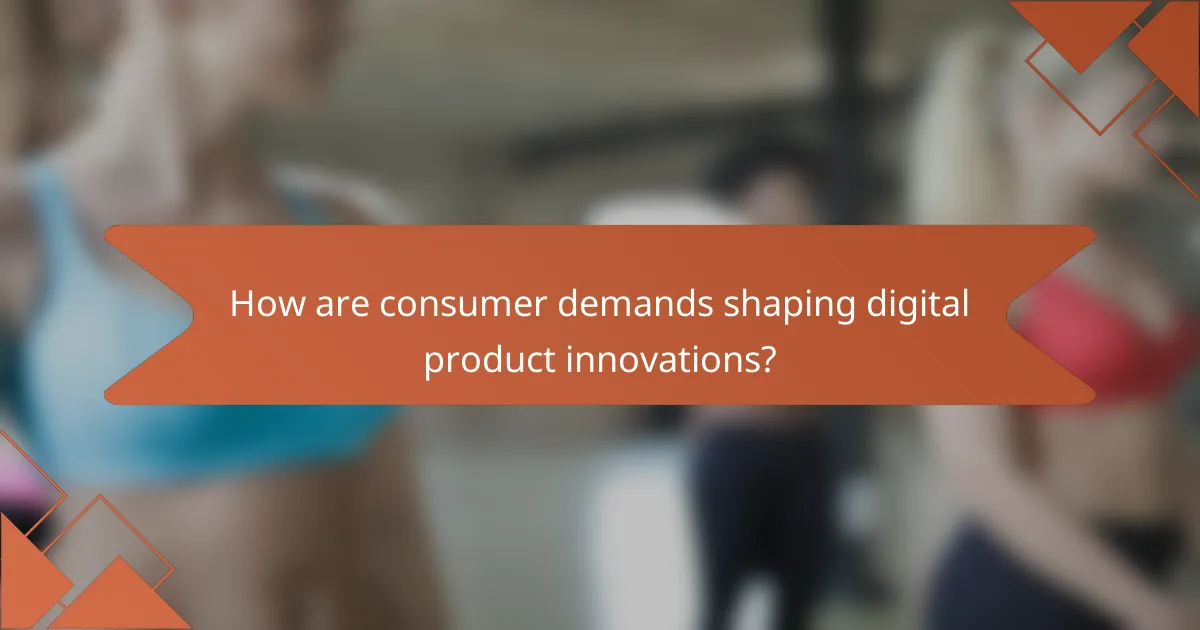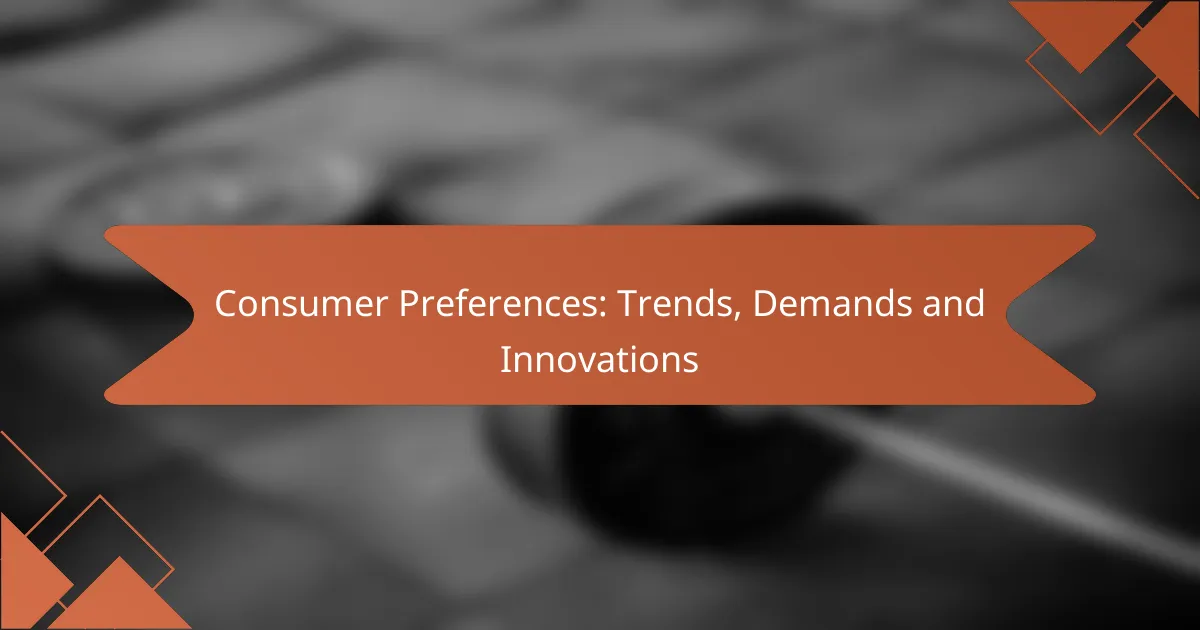In today’s market, consumer preferences are increasingly shaped by a desire for personalization, subscription models, and sustainability. As digital products evolve, businesses must respond to these demands by embracing innovative technologies and enhancing user experiences. The rise of mobile-first solutions and a focus on eco-friendly options further illustrate the changing landscape of consumer behavior in 2023.

What are the current consumer preferences in digital products?
Current consumer preferences in digital products emphasize personalization, subscription models, and sustainability. These trends reflect a shift towards tailored experiences, flexible payment structures, and environmentally conscious choices.
Increased demand for personalization
Consumers increasingly expect digital products to be tailored to their individual needs and preferences. Personalization can include customized content recommendations, user interfaces, and product features that adapt based on user behavior.
For example, streaming services often use algorithms to suggest shows and movies based on viewing history, enhancing user engagement. Brands that leverage data analytics to create personalized experiences can see higher customer satisfaction and loyalty.
Preference for subscription models
Many consumers now prefer subscription models over one-time purchases for digital products. This approach offers flexibility and access to a wide range of services without the upfront costs associated with traditional buying.
Popular examples include software as a service (SaaS) platforms like Adobe Creative Cloud and entertainment subscriptions like Netflix. These models often provide ongoing updates and new features, making them appealing to users who value continuous improvement and access.
Focus on sustainability
Sustainability is becoming a key consideration in consumer preferences for digital products. Many users are looking for brands that prioritize eco-friendly practices, such as reducing energy consumption and minimizing electronic waste.
Digital companies can enhance their appeal by adopting sustainable practices, such as using renewable energy sources for data centers or offering recycling programs for old devices. This focus not only attracts environmentally conscious consumers but also aligns with global efforts to combat climate change.

How are consumer demands shaping digital product innovations?
Consumer demands are driving digital product innovations by pushing companies to adopt new technologies and enhance user experiences. As preferences evolve, businesses must adapt their offerings to meet expectations for personalization, efficiency, and engagement.
Integration of AI and machine learning
The integration of AI and machine learning in digital products allows for more personalized experiences and improved functionality. These technologies analyze user behavior and preferences, enabling companies to tailor their offerings and predict future demands effectively.
For instance, e-commerce platforms use AI algorithms to recommend products based on past purchases, increasing the likelihood of sales. Companies should consider investing in AI solutions that align with their specific market needs to stay competitive.
Enhanced user experience through UX design
Enhanced user experience (UX) design is crucial for meeting consumer demands in digital products. A well-designed interface not only attracts users but also retains them by making interactions intuitive and enjoyable.
Focusing on elements like responsive design, accessibility, and user feedback can significantly improve UX. Companies should conduct regular usability testing and gather user insights to refine their designs and ensure they meet evolving consumer expectations.

What trends are influencing consumer behavior in 2023?
In 2023, consumer behavior is heavily influenced by the rise of mobile-first solutions and a growing preference for eco-friendly products. These trends reflect a shift in how consumers interact with brands and prioritize sustainability in their purchasing decisions.
Rise of mobile-first solutions
The mobile-first approach has become essential as consumers increasingly rely on smartphones for shopping and information. Brands are optimizing their websites and applications to ensure seamless experiences on mobile devices, which often includes faster loading times and user-friendly interfaces.
To effectively engage mobile users, businesses should focus on responsive design, easy navigation, and mobile payment options. For instance, enabling one-click purchases and integrating popular payment platforms can significantly enhance user satisfaction and conversion rates.
Shift towards eco-friendly products
Consumers are increasingly prioritizing eco-friendly products, driven by a heightened awareness of environmental issues. This trend compels brands to adopt sustainable practices, such as using recyclable materials and reducing carbon footprints in their production processes.
To appeal to eco-conscious shoppers, companies should clearly communicate their sustainability efforts and certifications. Offering products with minimal packaging or those made from renewable resources can attract this demographic, as many consumers are willing to pay a premium for environmentally friendly options.

What criteria should businesses consider for product development?
Businesses should focus on understanding consumer needs, market trends, and competitive landscape when developing products. These criteria help ensure that new offerings resonate with target audiences and stand out in the marketplace.
Understanding target demographics
Identifying target demographics is crucial for successful product development. Businesses should analyze factors such as age, gender, income level, and lifestyle preferences to tailor products effectively. For instance, a company targeting young professionals may focus on convenience and technology integration.
Utilizing surveys and market research can provide insights into consumer preferences. Engaging with potential customers through social media or focus groups can also reveal valuable information about their needs and expectations.
Analyzing market competition
Understanding the competitive landscape is essential for product differentiation. Businesses should assess competitors’ strengths and weaknesses, pricing strategies, and customer feedback to identify market gaps. This analysis helps in positioning new products effectively.
Creating a competitive matrix can simplify this process by comparing features, pricing, and customer satisfaction ratings. Regularly monitoring competitors allows businesses to adapt quickly to market changes and consumer demands, ensuring sustained relevance and appeal.

How can companies adapt to changing consumer preferences?
Companies can adapt to changing consumer preferences by embracing flexibility and responsiveness in their operations. This involves understanding market trends, actively engaging with customers, and implementing innovative practices that align with evolving demands.
Implementing agile development practices
Agile development practices allow companies to respond quickly to consumer feedback and market changes. By breaking projects into smaller, manageable segments, teams can iterate rapidly, making adjustments based on real-time insights.
For instance, a software company might release a minimum viable product (MVP) to gather user feedback before fully developing features. This approach minimizes wasted resources and aligns the final product more closely with consumer expectations.
Leveraging customer feedback
Actively seeking and utilizing customer feedback is crucial for understanding preferences. Companies can use surveys, focus groups, and social media interactions to gather insights that inform product development and marketing strategies.
For example, a retail brand might analyze customer reviews to identify common complaints or desired features, allowing them to make targeted improvements. Regularly engaging with customers fosters loyalty and ensures that offerings remain relevant in a competitive landscape.

What are the emerging technologies in digital products?
Emerging technologies in digital products include innovations like blockchain and augmented reality, which enhance transparency and user engagement, respectively. These technologies are reshaping consumer experiences and expectations across various industries.
Blockchain for transparency
Blockchain technology offers a decentralized ledger system that ensures transparency and security in digital transactions. By recording every transaction in a way that is immutable and verifiable, businesses can build trust with consumers, particularly in sectors like finance, supply chain, and healthcare.
Companies implementing blockchain can provide consumers with real-time tracking of products, verifying authenticity and ethical sourcing. For instance, a food company might use blockchain to show the journey of its products from farm to table, enhancing consumer confidence.
When considering blockchain, businesses should evaluate the costs of implementation and the need for technical expertise. It’s crucial to ensure that the benefits of transparency align with consumer demands and regulatory requirements in their specific market.
Augmented reality for enhanced engagement
Augmented reality (AR) enhances user engagement by overlaying digital information onto the real world. This technology allows consumers to interact with products in innovative ways, such as visualizing how furniture fits in their homes or trying on clothes virtually.
Retailers leveraging AR can improve customer experiences and boost sales. For example, a cosmetics brand might offer an app that lets users see how different makeup products look on their skin before making a purchase. This not only increases engagement but also reduces return rates.
To effectively implement AR, businesses should focus on user-friendly applications and ensure compatibility with a wide range of devices. Investing in quality AR experiences can differentiate a brand in a competitive market, but it’s essential to consider the target audience’s tech-savviness and preferences.
